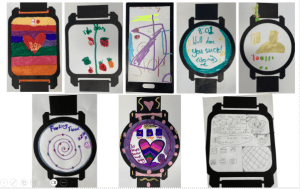JGI Seed Corn Funding Project Blog 2022-2023: Sydney Charitos & Lauren Thompson
Introduction
Due to the growth of self-tracking health devices, greater attention has been paid to how individuals view their health data. However, young children are often not the focus of these investigations. Instead, adult tools are applied and validated rather than starting from the children’s perspectives.
Aims
This project aimed to explore children’s views around visualising health data and to co-produce a set of designs/prototypes illustrating how health data can be better visualised for children. To do this, we are running a series of creative workshops with a class of 10–11-year-olds from a local school. We had both research aims and social aims throughout the project. These included:
Workshop 1:
Research Aim: Generate a range of data visualisations based on personas with invisible disabilities who represent ‘clients’. These personas represented children with different health conditions, with different motivations and requirements for tracking.
Social Aim: Educate the children about invisible disabilities, foster empathy towards the personas, provide healthy children with a broader understanding of the experiences of non-healthy children, and introduce the concept of co-design by involving them in the research process.
Workshop 2:
Social Aim: Teach the children to use BBC Micro:bits which are small electronic devices created to support children in developing electronics and computer science skills.
Workshop 3:
Research aim: Enable children to provide feedback and compare designs created by artists and academics interested in data visualisation. Subsequently, the children would create visualisations guided by designs based on their workshop 1 displays.
Social aim: Through comparison, children evidence and develop their skills of analysis and evaluation. These are higher-order processing skills which reflect a thorough understanding of the topic and are key steps on the way to intentional creation. Intentional creation is the ultimate goal as it evidences the full understanding of the context and application in education.
Workshop 4:
Research aim: Create a poster synthesising the children’s ideas into one display per persona.
Social aim: Children will show a full understanding of health data visualisation. They will do this by comprehending and responding to the three personas and adapting their ideas to those needs and preferences. This will show their ability to generate and adapt ideas when visualising health data and will be confirmed by their creation of a poster, on which they have also provided rationale for their choices – proving their consideration and conceptualisation. Children will furthermore work collaboratively, evidencing that skill of teamwork, to combine all of their ideas on each of the ‘clients’ into a singular large display. Through synthesising ideas, they will simultaneously evaluate and create in order to reflect their full understanding of both health data visualisation and how to adapt it to requirements.
Results
Since the project is still ongoing, we do not currently have results. However, we can share some displays that highlight interesting concepts. For more details, please reach out to us.

Future plans
After we complete all of the intended workshops, we will create a display to be placed on a wall at the school we have been working with. The children will then be able to show their work to their teachers, friends and parents. We intend to write up these results into a paper focusing on the methodology of the study as well as interesting and unexpected findings.
Contact details and links
Contact Sydney Charitos (sydney.charitos@bristol.ac.uk) or Lauren Thompson (lauren.thompson@bristol.ac.uk) for more information about the project.

